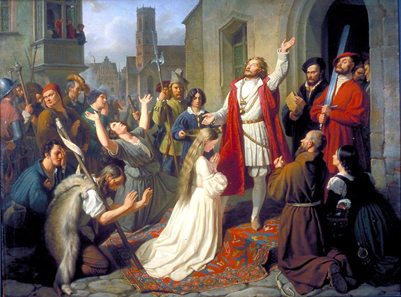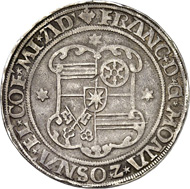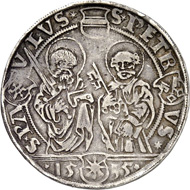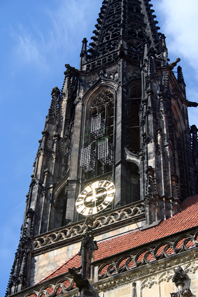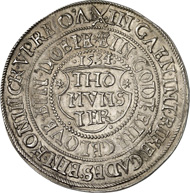Münster was no peaceful city in the first half of the 16th century. There, too, conflicts were smoldering between the proprietary ones and the craftsmen who suffered the most from the fluctuating conversion rates of fractions in heavy silver and gold coins. As in many cities, economic demands met with the enthusiasm for the young, Protestant movement that proclaimed a radically new reading of the good news. While the proprietary church in Münster used to preach that the social imbalances should be accepted with devout indifference, bold Theologians advocated instead an entirely new way of looking at things all of a sudden.
In the summer of 1532, the local assembly of guilds implemented the permission for the reformed clerics to preach in all of the parish churches. The old preachers were replaced – and the new ones preached in a much more radical manner than their colleagues in the Southern part of the Holy Roman Empire. They did not accept the Confessio Augustana, the universal confession of faith of the Protestants, and advocated the common priesthood of all believers, even the complete autonomy of every parish. These ideas undermined any kind of state authority. One wonders why the Prince-Bishop of Münster, Franz von Waldeck, didn’t take a stronger line with these preachers.
Well, there were a couple of reasons. First, he had just been appointed bishop, on 1 June 1532, hence he did not have enough time to learn the ropes. In addition, he himself was sympathetic to the new ideas. After all, he had a Lutheran chaplain in his retinue. And it was a matter of common knowledge that the prince-bishop had a female companion at his side. That might well have been the reason why Franz von Waldeck did not find it difficult at all to make a compromise with the Protestants: at the beginning of 1533, he granted Protestant preachers the official permission to sermonize in the parish churches at Münster as long as the churches and the monasteries under his control remained Catholic.
Johann Karl Ulrich Bähr, Jan van Leiden baptising a girl during the Münster Rebellion, 1840. Source: Wikicommons.
That was his attempt to defuse the situation, but he achieved quite the opposite. The newly gained liberty attracted many radical Anabaptists that had been chased elsewhere to the city. Under their influence, the Anabaptists secured a majority in the city council. After most Catholics had already left Münster, the moderate Protestants followed at this point. That cleared the way for the infamous Anabaptist Commune where not only polygamy was introduced but the community of goods following the model of the first Christian community at Jerusalem. To wipe out any trace of previous propriety, the Anabaptists even burned down the city archive.
And during that turbulent year the dies of the famous ‘wiedertäuferthaler’ were created. In accordance with the ban on images of the Old Testament, they settle for pious quotations as decoration. The inscription covers both sides and translates: ‘The Word became flesh and dwelt among us. Unless a man be born again of water and the Holy Spirit, he cannot enter into the kingdom of God; one king upright above all; one Lord, one faith, one baptism.’
When this thaler was produced, the army of Bishop Franz von Waldeck stood right at the gates of the city. Because it was one thing to tolerate the reformation as long as the churchly propriety and, most of all, the state’s power were not affected. An independent commune of Anabaptists, however, which was beyond any control, was quite another thing that even a politician favorable towards Protestantism could not accept. The circumvallation was completed, and the end of the Anabaptists therewith sealed. The suffering of the ones under siege and the dreadful famine took another one and a half years until finally, on 24 June 1535, the city was taken and the Commune of the Anabaptists perished in a bloodbath.
Münster. Franz von Waldeck, 1532-1553. 1/2 thaler 1535, Münster. Ilisch XXX. 4. From auction sale Künker 249 (1 July 2014), 1716. The extremely rare piece is estimated at 10,000 euros.
On the occasion of the recapture, Bishop Franz von Waldeck had not only the gorgeous thaler minted that can occasionally be encountered, but likewise 1/2 thaler displaying the same subject, the principal saints of Münster Peter and Paul. The specimen depicted here is extremely rare and part of the upcoming Künker auction sale #249 to be conducted on 1 July 2014 in which the special collection Dieter Braun is going to be offered for sale. It comprises coins from Münster and Westphalia and had been assembled over the course of more than 40 years.
Tower of St. Lambert’s Church, Münster. Above the clock three iron cages are suspended in which the corpses of the executed Anabaptists had been put on display. Photograph: Wikipedia / Jule Hintzbergen. CC-Lizenz 3.0.
By the way, there is one thing that should not go unmentioned: the leaders of the commune, Jan van Leiden, Bernd Krechting and Bernd Knipperdolling, were executed quite some time after the siege had already been terminated. As a deterrent for potential sympathizers, they, being kept in baskets, had been presented for half a year in the entire bishopric, until they were virtually torn into pieces in front of St. Lambert’s Church in Münster on 22 January. Their remains were then suspended from the steeple of St. Lambert’s Church in iron cages, so that ‘they might serve to all restless spirits as a warning and a scare and so prevent them from trying and daring to do something of the kind in the future’. And this is where they hang until the present day.
Münster. Thaler 1634, restrike from the 17th century. Dav. 9583var. Geisberg 12. From auction sale Künker 249 (1 July 2014), 1838.
They most likely give today’s tourists the creeps just like the visitors to the big diplomatic congress from 1645 to 1648 for which any number of restrikes of the wiedertäuferthaler were produced as a souvenir.
You can read a complete preview of this auction here.
You can find the auction here.




